Nikko
Nikko has been inscribed as a World Heritage site in1999, a registered wetlands under the Ramsar Convention, listed in the Guinness Book of World Records as the world's longest tree-lined street, and awarded the highest rating of three stars in the Michelin Guide.
It takes only 2 hours from Tokyo's Asakusa district by Tobu Railway Line; about 125km/77ml north of Tokyo. Nikko is the most famous for the mausoleums of the Tokugawa shoguns.
Today, Nikko is on the list of most popular touring spot amongst international travelers.
Moreover, Nikko has been known as a “sacred place” since the 8th century;the time when a Buddhist hermitage was established here in Nikko.
Today, several shrines and temples are clustered there with amid a magnificent forest of over 13,000 cedar trees that has been listed in the Guiness Book of World Records.
NIKKO TOURS LIST
The Architectural 90th Anniversary Commemoration
Belgium Kingdom Embassy Villa Special Public Release
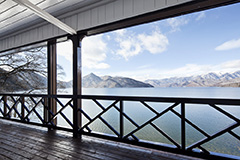
"Belgian embassy villa" on the banks of Oku-Nikko and Chuzenji Lake will be open to the public for a limited time as a special project for "Tochigi Destination Campaign" to commemorate the 90th anniversary of the building. This is the first time to open to the public, because it is still used at present.
Open : Saturday, Sunday and Monday in June 2018 (12 days except for June 30)
see more details
Toshogu Shrine:The World Heritage Site
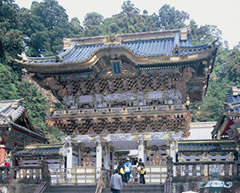
The Toshogu Shrine is the main attraction of Nikko area.
The Shrine is where Tokugawa Ieyasu, who founded the shogunate in Edo period, is enshrined.
The main attraction of the shrine is the Yomemon Gate, one of Japan's most magnificent national treasures, and decorated with detailed carvings of mythical creatures. The height of its gate is 11.1m/36.4ft with double layered.
As legend goes, ancient people thought that the perfection was the beginning of the declination. Therefore, on purpose, buildings in Toshogu Shrine were constructed with imperfect structure such a upside-down pattern on one of Yomei-mon's pillars.
Rinno-ji Temple:The World Heritage Site
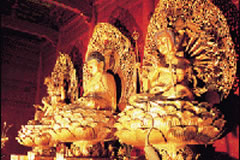
Rinno-ji Temple contains three “gohonzon” shrines to which the faithful come to pray for the welfare of their families and the safety of the nation.
The building's 25-meter-tall pillars are each made from a single tree and coated with over 30 layers of lacquer.
The best time of year to visit is in the fall or winter.
Futarasan Shrine:The World Heritage Site
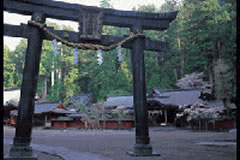
Located next to Tosho-gu Shrine, Futarasan Shrine is said to be the oldest structure on Mt. Nikko.
The shrine is also famous for its copper-tiled of front shrine, and eight-gabled roof of main shrine.
The “monster stone lanterns” bear the sword marks of samurai warriors who mistook them for monsters and sliced at them in the darkness.
Shinkyo Bridge
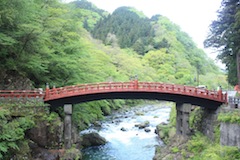
Considered one of the three most unique bridges in all Japan, the Shinkyo Bridge is also a registered World Heritage site.
According to legend, in ancient times the benevolent god Jinsha first made a bridge here with two giant snakes—one red, one green—to ferry pilgrimaging monks across the gorge.
Akechidaira Ropeway
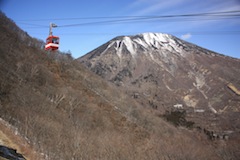
From Akechidaira, located near the end of the No. 2 Irohazaka road, take the Akechidaira Ropeway for a 3-minute ride to the top.
The view there is the best in all of Nikko: To the west, Lake Chuzenji, Kegon Falls, and Mt. Nantai; to the east, cliff-sided mountains and a rolling mountain range.
Lake Chuzenji
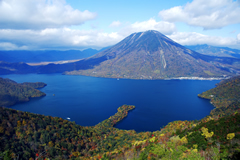
The Lake Chuzenji, 24km/15ml round and 163m/535ft max. depth, was created through the volcanic activity of Mt. Nantai.
The key to its popularity is the most transparent water in Japan with surrounding beautiful natures.
Pleasure boats allow visitors to enjoy the lake up close.
Italian Embassy Villa Memorial Park
Italian Embassy Villa Memorial Park was founded in 1928 for the former summer retreat of the Italian Ambassador towards Japan.
The successive Italian Ambassadors actually stayed there, and enjoyed Nikko during summer season until 1997.
It is located on the southeastern shore of Lake Chuzenji. It has donated to Tochigi Prefecture and opened to the public since 1999.
The Embassy Villa Memorial park has recently attached to café shop, named “Café COCO.”
Kegon Falls
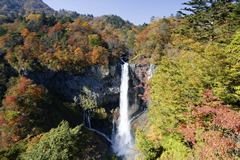
Located at the Lake Chuzenji in Nikko National Park, the Kegon falls is known as the highest water falls in Japan.: 97m/318ft high.
The Kegon Falls is on the Japan's 3-finest waterfalls.
The Tamozawa Imperial Villa Memorial Park
The Tamozawa Imperial Villa Memorial Park (Former Tamozawa Imperial Villa) was built in 1899 for the purpose of the
Emperor of Taisho's rest.
Emperor Taisho had spent the time in every summer season since 1925.
Moreover, Emperor Showa and Empress Koujun also stayed there.
Bakejizo:Mysterious Stone Statue
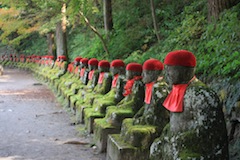
Located 1km/0.6mile upstream from the Shinkyo bridge, very interesting historical stone statues are lined up.
The name of Bake-jizo derives from a story; if you count stone statues from left to right and from right to left, there never comes up the same number. legendary, the statues move to change places from time to time.
Senjogahara Plateau: Registered wetlands under the Ramsar Convention
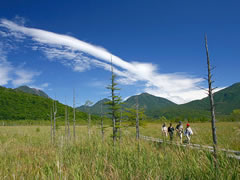
Senjogahara plateau is one of the representative marshland in Japan.
It is 400ha wide. Plus, alpine plants such as lonicera caerulea, cotton sedge, polygonum bistorta, iris ,and spiraea salicifolia are on the ground.
Ryuzu Falls
Located upside of the Yugawa River which makes its way into Lake Yuno and Lake Chuzenji, Ryūzu falls has a very unique shape.
The name, Ryuzu, can be translated as "Dragon's Head', and is so named because its twin falls are said to resemble a dragon's head. Total height of its falls is 60m / 197ft.
Kotoku Ranch
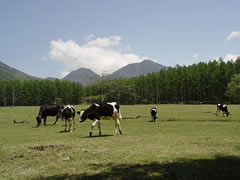
The Kotoku Ranch is 30,000㎡/3ha, and cattle and horse are pastured.
A fresh milk and a fine ice cream are available for purchase.
Lake Yuno Registered wetlands under the Ramsar Convention
Hearing the voice of the gentle wind with birds singing, the Lake Yuno is a highly recommened place for hiking.
The circumference is only 3km/1.9ml, and it takes about 1 hour only to walk the path around the lake.
Yudaki Falls
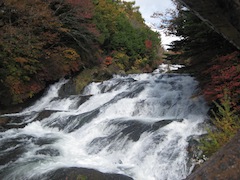
Located on the edge of the Lake Yuno, Yudaki Fall is very aggressive, 70m / 230ft high and 25m / 82ft wide cascade.
Hot spring runs together, hence, it has a very delicate softly-scented of sulfur in the air.
Yumoto Onsen with Yunodaira Marshland
The history of Yumoto Onsen can track back to 1200 years ago. Priest Shoto found the hot spring in 788b.c., and named it Yakushiyu (hot spring of Yakushi). That was the beginning of Yumoto Onsen.
The Onsen is hydrogen sulfide based on. The source of the spring is located in Yunodaira Marshland. Visitors can see that the hot spring is coming out to the ground.
Odashirogahara Plateau:Registered wetlands under the Ramsar Convention
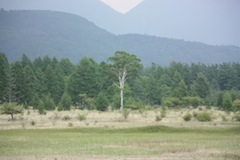
Odashirogahara plateau is located at the west side of Yugawa river, which size is 2km/ 6 561ft around field of grass spread out, with surrounded by mongolian oak woods.
The place is totally suitable for hikers especially during summer season.
The highly interesting around the plateau is a Japanese white birch tree, which is called “the lady of Odashirogahara,” and very popular amongst photographers.
Nonetheless to say, greatly enjoyable the changing colors of maple trees during the autumn season.
Kirifuri Highland
Spring offers the azaleas of Tsutsujigaoka (“Azalea Hill”), early summer the yellow alpine lilies of Kisugedaira (“Alpine Lilly Plain”), fall the rich red and yellow autumnal foliage of the entire plateau, and winter skiing at the Kirifuri Kogen Ski Resort.
Each season offers its own unique sights to see. Various leisure facilities allow you to experience nature up close.
Kirifuri Falls
Kirifuri Falls is recognized as one of 3 major finest waterfalls of Nikko area.
The fall is divided into two steps of upper and lower side. The upper side is 25 m/ 82ft high, and lower side is 26 m/ 85ft high. The total height of its fall is 75 m /246ft.
The water, of which the lower side of the fall, hit rocks, and as if wrapped in fog The fall is said to be named after this natural spray phenomenon.
* kirifuri: fog comes down.





